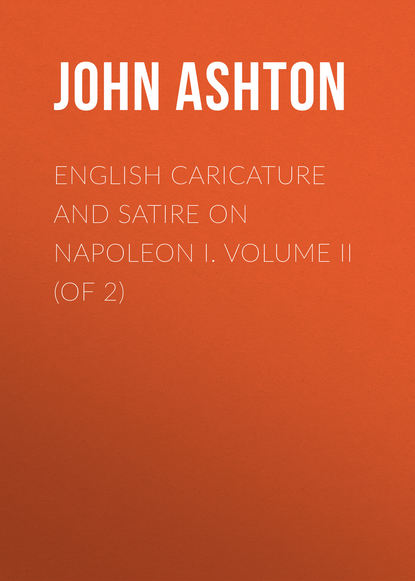По всем вопросам обращайтесь на: info@litportal.ru
(©) 2003-2024.
✖
English Caricature and Satire on Napoleon I. Volume II (of 2)
Настройки чтения
Размер шрифта
Высота строк
Поля
One of the most singular caricatures, in connection with the projected invasion, that I have met with is by Ansell, January 6, 1804. ‘The Coffin Expedition, or Boney’s Invincible Armada Half seas over.’ The flotilla is here represented as gunboats, in the shape of coffins: all the crews, naval and military, wearing shrouds; whilst at the masthead of each vessel is a skull with bonnet rouge. It is needless to say they are represented as all foundering, one man exclaiming, ‘Oh de Corsican Bougre was make dese Gun boats on purpose for our Funeral.’ Some British vessels are in the mid distance, and two tars converse thus: ‘I say Messmate, if we dont bear up quickly, there will be nothing left for us to do.’ ‘Right, Tom, and I take them there things at the Masthead to be Boney’s Crest, a skull without brains.’
‘Dutch Embarkation; or Needs must when the Devil drives!!’ (artist unknown, January 1804) represents Bonaparte, with drawn sword, driving fat, solid Dutchmen each into a gun-boat about as big as a walnut-shell. One remonstrates: ‘D – n such Liberty, and D – n such a Flotilla!! I tell you we might as well embark in Walnut Shells.’ But Bonaparte replies: ‘Come, come, Sir, no grumbling, I insist on your embarking and destroying the modern Carthage – don’t you consider the liberty you enjoy – and the grand flotilla that is to carry you over!’
As good a one as any of Gillray’s caricatures is the King of Brobdingnag and Gulliver, February 10, 1804 – scene, ‘Gulliver manœuvring with his little boat in the cistern.’ The king and queen (excellent likenesses) and two princesses are looking on at Bonaparte sailing, whilst the young princes are blowing, to make a wind for him. Lord Salisbury stands behind the royal chair, and beefeaters and ladies of the court complete the scene. This, however, is specially described as ‘designed by an amateur, etched by Gillray.’
‘A French Alarmist, or John Bull looking out for the Grand Flotilla!!’ (West, March 1804.) He is on the coast, accompanied by his bull-dog, and armed with a sword, looking through a telescope. Behind him is a Frenchman, who is saying, ‘Ah! Ah! Monsieur Bull, – dere you see our Grande flotilla – de grande gon boats – ma foi – dere you see em sailing for de grand attack on your nation – dere you see de Bombs and de Cannons – Dere you see de Grande Consul himself at de head of his Legions. Dere you see – ’ But John Bull replies, ‘Mounseer, all this I cannot see – because ’tis not in sight.’
We now come to the caricatures relating to the Empire.
A print, attributed to Rowlandson (May 1804?), shows ‘A Great Man on his Hobby Horse, a design for an Intended Statue on the Place la Liberté at Paris.’ Napoleon is riding the high horse ‘Power,’ which prances on a Globe.
‘A new French Phantasmagoria’ is by an unknown artist (May 1804). John Bull cannot realise the fact of Napoleon being Emperor, but stares at him through an enormous pair of spectacles. ‘Bless me, what comes here – its time to put on my large spectacles, and tuck up my trowsers. Why, surely, it can’t be – it is Bonny too, for all that. Why what game be’st thee at now? acting a play mayhap. What hast thee got on thy head there? always at some new freak or other.’ Bonaparte, in imperial robes, and with crown and sceptre, holds out his hand, and says: ‘What! my old Friend, Mr. Bull, don’t you know me?’
Ansell gives us (May 28, 1804) ‘The Frog and the Ox, or The Emperor of the Gulls in his stolen gear.’ Napoleon, very small, is depicted as capering about in imperial robes, with an enormous crown made of coins, daggers, and a cup of poison; his sceptre has for its top a guillotine. George the Third is regarding him through his glass. Napoleon says, ‘There Brother! there! I shall soon be as Big as you, it’s a real Crown, but it’s cursed heavy, my Head begins to ache already. I say Can’t we have a grand meeting like Henry the 8th and Francis the 1st?’ King George cannot quite make out the mannikin. ‘What have we got here, eh? A fellow that has stolen some Dollars, and made a Crown of them, eh? and then wants to pass them off for Sterling; it won’t go, it won’t pass Fellow.’ Beside the King is a bull, and behind Napoleon is a frog, who is trying to swell to the bull’s proportions, whilst John Bull laughingly remarks, ‘Dang it, why a looks as tho a’d burst: a’l nerr be zo big as one of our Oxen tho.’
‘Injecting blood Royal, or Phlebotomy at St. Cloud,’ shews Napoleon, in his new phase of power, having the blood of a Royal Tiger infused into his veins. He says, ‘It’s a delightful operation! I feel the Citizenship oozing out at my fingers’ ends. – let all the family be plentifully supplied! Carry up a Bucket full to the Empress immediately!!!’
In June 1804 I. Cruikshank drew a picture called ‘the Right Owner.’ Louis the Eighteenth appears to Napoleon, and, pointing to his crown, says, ‘That’s Mine.’ Napoleon, who is seated on his throne, armed with sword, pistols, and dagger, shrinks back in violent alarm, exclaiming, ‘Angels and Ministers of Grace defend me.’
‘A Proposal from the New Emperor’ is a caricature by Ansell (July 9, 1804). He comes, cap, or rather crown, in hand, to John Bull, saying, ‘My Dear Cousin Bull – I have a request to make you – the good people whom I govern, have been so lavish of their favors towards me – that they have exhausted every title in the Empire – therefore, in addition, I wish you to make me a Knight of Malta.’ John Bull replies, ‘I’ll see you d – d first!! You know I told you so before.’
‘The Imperial Coronation’ is a very inartistic sketch by an unknown artist (July 31, 1804). Napoleon is being crowned by the Pope, who says, ‘In a little time you shall see him, and in a little time you shall not see him,’ and then lets down the crown, with cruel force, by a rope and pulley from the gibbet from which it has been suspended. Its weight crushes him through the platform on which he has been sitting, and he exclaims, ‘My dear Talleyrand, save me; My throne is giving way. I am afraid the foundation is rotten, and wants a deal of mending.’ Talleyrand sympathisingly answers, ‘Oh, Master, Master, the Crown is too heavy for you.’
I. Cruikshank drew ‘Harlequin’s last Skip’ (August 23, 1804). Bonaparte is represented in a harlequin’s suit, enormous cocked hat, boots, and a blackened face. His sword is broken, and, with upraised hands, in a supplicating attitude, he exclaims, ‘O Sacre Dieu! John Bull is de very Devil.’ John Bull, with upraised cudgel, says: ‘Mr. Boney Party, you have changed Characters pretty often and famously well, and skipped about at a precious rate. But this Invasion hop is your last – we have got you snug – the devil a trap to get through here – Your conjuration sword has lost its Power; you have lied till you are black in the face, and there is no believing a word you say – so now you shall carry John Bull’s mark about with you, as every swaggerer should.’
‘British men of war towing in the Invader’s Fleet,’ artist unknown (September 25, 1804), shows a number of English sailors seated on the necks of French and Dutch men, whom they are guiding over the sea to England. One sailor, evidently a Scotchman, is pulling his opponent’s ears; the poor Frenchman cries out, ‘Oh Morbleu! de salt water make me sick; O mine pauvre Ears!’ but his ruthless conqueror has no pity, ‘Deil tak your soul, ye lubberly Loon, gin ye dinna mak aw sail, I’ll twist off your lugs.’ An English sailor rides the redoubtable Boney, and pulls his nose: ‘Steady Master Emperor, if you regard your Imperial Nose. Remember a British Tar has you in tow – No more of this wonderful, this great and mighty nation who frighten all the world with their buggabo invasion.’ But Boney pleads, ‘Oh! mercy, take me back, me will make you all Emperors; it will be Boney here, Boney there, and Boney everywhere, and me wish to my heart me was dead.’ An Irish sailor on a Dutchman yells out, ‘By Jasus, my Jewel, these bum boats are quizzical toys and sure – heave ahead, you bog trotting spalpeen, or I shall be after keel hauling you. Huzza, Huzza, Huzza, my boys, Huzza! ’Tis Britannia boys, Britannia rules the waves.’ Another Dutchman complains, ‘O Mynheer Jan English you vill break my back.’ But the relentless sailor who bestrides him takes out his tobacco-box, and says, ‘Now for a quid of comfort! pretty gig for Jack Tars. Good bye to your bombast, we’re going to Dover, Was ever poor Boney, so fairly done over.’
A most remarkable caricature by Ansell (October 25, 1804) shows to what length party spirit will lead men – making truth entirely subservient to party purposes. It probably paid to vilify Napoleon, and consequently this picture was produced. It is called ‘Boney’s Inquisition. Another Specimen of his Humanity on the person of Madame Toussaint.’ Whatever may be our opinion of his treatment of Toussaint l’Ouverture, the only record we have in history (and I have expended much time and trouble in trying to find out the truth of the matter) is that his family, who were brought to France at the same time as himself, took up their residence at Agen, where his wife died in 1816. His eldest son, Isaac, died at Bordeaux in 1850. Now to describe the picture. Madame l’Ouverture is depicted as being bound to a stretcher nearly naked, whilst three Frenchmen are tearing her breasts with red-hot pincers. Another is pulling out her finger-nails with a similar instrument. She exclaims: ‘Oh Justice! Oh Humanity, Oh Deceitfull Villain, in vain you try to blot the Character of the English: ’tis their magnanimity which harrasses your dastard soul.’ One of the torturers says: ‘Eh! Diable! Why you no confess noting?’ Napoleon is seated on his throne, watching the scene with evident delight, chuckling to himself, ‘This is Luxury. Jaffa, Acre, Toulon and D’Enghien was nothing to it. Slave, those pincers are not half hot, save those nails for my Cabinet, and if she dies, we can make a confession for her.’
‘The Genius of France nursing her darling’ is by a new hand, T. B. d – lle (November 26, 1804). ‘France, whilst dandling her darling, and amusing him with a rattle, sings —
There’s a little King Pippin
He shall have a Rattle and Crown;
Bless thy five Wits,[2 - False of Heart, light of Ear, bloody of Hand,Fox in Stealth, Wolf in Greediness, Dog in Madness,Lion in Prey; – bless thy five Wits.King Lear, act iii. scene 4.] my Baby,
Mind it don’t throw itself down!
Hey my Kitten, my Kitten, &c.
An unknown artist (December 11, 1804) gives us ‘The death of Madame Republique.’ Madame lies a corpse on her bed. Sieyès, as nurse, dandles the new emperor. John Bull, spectacles on nose, inquires, ‘Pray Mr. Abbé Sayes – what was the cause of the poor lady’s Death? She seem’d at one time in a tolerable thriving way.’ Sieyès replies, ‘She died in Child bed, Mr. Bull, after giving birth to this little Emperor.’
‘The Loyalist’s Alphabet, an Original Effusion,’ by James Bisset (September 3, 1804), consists of twenty-four small engravings, each in a lozenge.
‘A, stands for Albion’s Isle,’ – Britannia seated.
‘B, for brave Britons renown’d.’ – A soldier and sailor shaking hands.
‘C, for a Corsican tyrant,’ – Napoleon, with a skull, the guillotine, &c., in the background.
‘D, his dread downfall must sound.’ – Being hurled from his throne by lightning.
‘E, for embattl’d we stand,’ – A troop of soldiers.
‘F, ’gainst the French our proud Foes,’ – shews England guarded by her ships,’ and the flotilla coming over.
‘G, for our glorious Gunners,’ – Three artillerymen, and a cannon.
‘H, for Heroical blows,’ – shews a ship being blown up.
‘I, for Invasion once stood,’ – Some soldiers carousing. The English flag above the tricolour.
‘J, proves ’twas all a mere Joke.’ – A soldier laughing heartily, and holding his sides.
‘K, for a favorite King, to deal against Knaves a great stroke. – Medallion of George the Third.
‘L, stands for Liberties’ laws,’ – A cap of liberty, mitre, pastoral staff, crown, and open book.
‘M, Magna Charta’s strong chain.’ – A soldier, sailor, Highlander, and civilian, joining hands.
‘N, Noble Nelson, whom Neptune, near Nile crown’d the Lord of the Main,’ – is a portrait of the Hero.
‘O, stands for Britain’s fam’d Oak,’ – which is duly portrayed.
‘P, for each brave British Prince.’ – The three feathers show the Prince of Wales, in volunteer uniform.
‘Q, never once made a Question, Respecting the Deeds they’d evince,’ – is an officer drawing his sword.
‘If R, for our Rights takes the field,’ – is a yeomanry volunteer.
‘Or S, should a signal display,’ – The British Standard.
‘They’d each call with T for the Trumpet. To Horse my brave boys and away.’ – A mounted Trumpeter.
‘U, for United, we stand, V for our bold Volunteers,’ – represents one of the latter.
‘Whom W welcomes in War, and joins loyal X in three Cheers.’ – A soldier and sailor, with hands clasped, cheering.
‘With Y all our Youths sally forth, the standards of Freedom advance,’ – is a cannon between two standards.
‘With Z proving Englishmen’s Zeal, to humble the Zany of France,’ – shews Napoleon with a fool’s cap on, chained to the wall in a cell.
CHAPTER XL
NAPOLEON’S CORONATION
Napoleon’s coronation was the great event of the year; but some time before it was consummated the English caricaturist took advantage of it, and J. B. (West), in September 1804, produced a ‘Design for an Imperial Crown to be used at the Coronation of the New Emperor.’ A perusal of the foregoing pages will render any explanation unnecessary.
Napoleon omitted no ceremony which could enhance the pageant of his coronation. The Pope must be present: no meaner ecclesiastic should hallow this rite, and he was gently invited to come to Paris for this purpose. Poor Pius VII. had very little option in the matter. His master wanted him, and he must needs go; but Napoleon gilded the chain which drew him. During the whole of his journey he was received with the greatest reverence, and could hardly have failed to have been impressed with the great care and attention paid to him. For instance, the dangerous places in the passage of the Alps were protected by parapets, so that his Holiness should incur no danger. On his arrival at Paris he was lodged in the Tuileries, and a very delicate attention was paid him – his bedchamber was fitted as a counterpart of his own in the palace of Monte-Cavallo, at Rome.
The eventful 2nd of December came at last; but, before we note the ceremony itself, we must pause awhile to see how the English caricaturist treated the procession.











